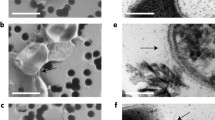Abstract
Hydrogen consumption by various thermophilic, mesophilic and/or psychrotrophic homoacetogens and methanogens was measured at temperatures between 4 and 80°C. Within the tolerated temperature range H2 was consumed until a final H2 threshold partial pressure was reached. H2 thresholds generally decreased with temperature, parallel to the values calculated from the thermodynamics prevailing under culture conditions, i.e. the Gibbs free energy (ΔG) of H2 oxidation corrected for temperature by both the free-energy form of the Nernst equation and the Van't Hoff equation. The difference between the observed and the calculated H2 partial pressures gives the minimum energy required for H2 utilization being about-5 to-6 kJ/mol H2 for the homoacetogenes and-9 to-12 kJ/mol H2 for methanogens. The temperature dependence of the standard Gibbs free energy (ΔG0) as described by the Van't Hoff equation apparently became the more important for thermodynamics as well as H2 thresholds the more the temperature deviated from standard conditions (i.e. 25°C). Correction factors for calculation of temperature-corrected ΔG sup0infT are presented for various H2-producing and H2-consuming reactions.
Similar content being viewed by others
References
Archer DB, Harris JE (1986) Methanogenic bacteria and methane production in various habitats. In: Barnes EM, Mead GC (eds) Anaerobic bacteria in habitats other than man. Blackwell, Oxford, pp 185–223
Bache R, Pfennig N (1981) Selective isolation of Acetobacterium woodii on methoxylated aromatic acids and determination of growth yields. Arch Microbiol 130:255–261
Conrad R, Bak F, Seitz HJ, Thebrath B, Mayer HP, Schütz H (1989) Hydrogen turnover by psychrotrophic homoacetogenic and mesophilic methanogenic bacteria in anoxic paddy soil and lake sediment. FEMS Microbiol Ecol 62:285–294
Cord-Ruwisch R, Seitz HJ, Conrad R (1988) The capacity of hydrogenotrophic anaerobic bacteria to compete for traces of hydrogen depends on the redox potential of the terminal electron acceptor. Arch Microbiol 149:350–357
Dolfing J (1988) Acetogenesis. In: Zehnder AJB (ed) Biology of anaerobic microorganisms. Wiley, New York, pp 417–468
Dwyer DF, Weeg-Aerssens E, Shelton DR, Tiedje JM (1988) Bioenergetic conditions of butyrate metabolism of a syntrophic, anaerobic bacterium in coculture with hydrogen-oxidizing methanogenic and sulfidogenic bacteria. Appl Environ Microbiol 54:1354–1359
Gujer W, Zehnder AJB (1983) Conversion processes in anaerobic digestion. Water Sci Technol 15:127–167
Lange NA (1967) Handbook of chemistry. McGraw-Hill, New York
Lee MJ, Zinder SH (1988a) Hydrogen partial pressures in a thermophilic acetate-oxidizing methanogenic coculture. Appl Environ Microbiol 54:1457–1461
Lee MJ, Zinder SH (1988b) Isolation and characterization of a thermophilic bacterium which oxidizes acetate in syntrophic association with a methanogen and which grows acetogenically on H2−CO2. Appl Environ Microbiol 54:124–129
Ljungdahl LG (1986) The autotrophic pathway of acetate synthesis in acetogenic bacteria. Annu Rev Microbiol 40:415–450
Lovley DR (1985) Minimum threshold for hydrogen metabolism in methanogenic bacteria. Appl Environ Microbiol 49:1530–1531
Schütz H, Seiler W, Conrad R (1990) Influence of soil temperature on methane emission from rice paddy fields. Biogeochem (in press)
Seitz HJ, Schink B, Conrad R (1988) Thermodynamics of hydrogen metabolism in methanogenic cocultures degrading ethanol or lactate. FEMS Microbiol Lett 55:119–124
Seitz HJ, Schink B, Pfennig N, Conrad R (1990) Energetics of syntrophic ethanol oxidation in defined chemostat cocultures. 1. Energy requirement for H2 production and H2 oxidation. Arch Microbiol 155:82–88
Stumm W, Morgan JJ (1981) Aquatic chemistry. An introduction emphasizing chemical equilibria in natural waters. Wiley, Chichester
Thauer RK, Jungermann K, Decker K (1977) Energy conservation in chemotrophic anaerobic bacteria. Bacteriol Rev 41:100–180
Westermann P, Ahring BK, Mah RA (198) Temperature compensation in Methanosarcina barkeri by modulation of hydrogen and acetate affinity. Appl Environ Microbiol 55:1262–1266
Widdel F, Pfennig N (1981) Studies on dissimilatory sulfate-reducing bacteria that decompose fatty acids. I. Isolation of new sulfate-reducing bacteria enriched with acetate from saline environments. Description of Desulfobacter postgatei gen. nov., sp. nov. Arch Microbiol 129:395–400
Author information
Authors and Affiliations
Rights and permissions
About this article
Cite this article
Conrad, R., Wetter, B. Influence of temperature on energetics of hydrogen metabolism in homoacetogenic, methanogenic, and other anaerobic bacteria. Arch. Microbiol. 155, 94–98 (1990). https://doi.org/10.1007/BF00291281
Received:
Accepted:
Issue Date:
DOI: https://doi.org/10.1007/BF00291281




